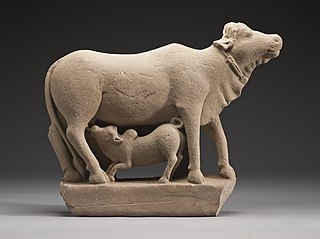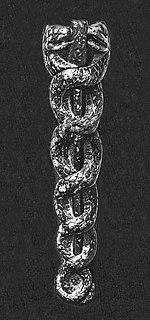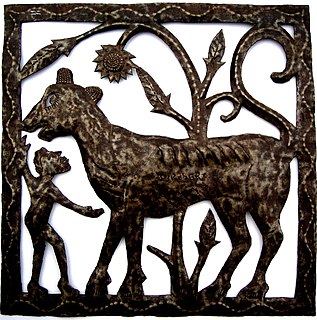 W
WThe position and treatment of animals in Buddhism is important for the light it sheds on Buddhists' perception of their own relation to the natural world, on Buddhist humanitarian concerns in general, and on the relationship between Buddhist theory and Buddhist practice.
 W
WThe respect for animal rights in Jainism, Hinduism, and Buddhism derives from the doctrine of ahimsa.
 W
WBuddhist vegetarianism is the practice of vegetarianism by significant portions of Mahayana Buddhist monks and nuns and some Buddhists of other sects. In Buddhism, the views on vegetarianism vary between different schools of thought. The Mahayana schools generally recommend a vegetarian diet because Gautama Buddha set forth in some of the sutras that his followers must not eat the flesh of any sentient being.
 W
WDue to the multiple benefits from cattle, there are varying beliefs about cattle in societies and religions. In some regions, especially most states of India, the slaughter of cattle is prohibited and their meat may be taboo.
 W
WCattle slaughter, especially cow slaughter, is a controversial topic in India because of cattle's traditional status as an endeared and respected living being to adherents of Hinduism, Sikhism, Jainism, Buddhism, and Parsiism while being considered an acceptable source of meat by Muslims and Christians as well as adherents of other non-Dharmic Religions in India, such as the Animists and Irani Zoroastrians. More specifically, the cow's slaughter has been shunned because of a number of reasons such as being associated with god Krishna in Hinduism, cattle being respected as an integral part of rural livelihoods and an economic necessity. Cattle slaughter has also been opposed by various Indian religions because of the ethical principle of Ahimsa (non-violence) and the belief in the unity of all life. Legislation against cattle slaughter is in place throughout most states of India except Kerala, Goa, West Bengal, and states of Northeast India.
 W
WThe Cock, the Dog and the Fox is one of Aesop's Fables and appears as number 252 in the Perry Index. Although it has similarities with other fables where a predator flatters a bird, such as The Fox and the Crow and Chanticleer and the Fox, in this one the cock is the victor rather than victim. There are also Eastern variants of this story.
 W
WA Deer of Nine Colors is a Chinese animated film produced by Shanghai Animation Film Studio. It is also referred to as "The Nine Colored Deer".
 W
WThe Dog and Its Reflection is one of Aesop's Fables and is numbered 133 in the Perry Index. The Greek language original was retold in Latin and in this way was spread across Europe, teaching the lesson to be contented with what one has and not to relinquish substance for shadow. There also exist Indian variants of the story. The morals at the end of the fable have provided both English and French with proverbs and the story has been applied to a variety of social situations.
 W
WThe Fox and the Crow is one of Aesop's Fables, numbered 124 in the Perry Index. There are early Latin and Greek versions and the fable may even have been portrayed on an ancient Greek vase. The story is used as a warning against listening to flattery.
 W
WThe Fox and the Sick Lion is one of Aesop's Fables, well known from Classical times and numbered 142 in the Perry Index. There is also an Indian analogue. Interpretations of the story's meaning have differed widely in the course of two and a half millennia.
 W
WHares are proverbially timid and a number of fables have been based on this behaviour. The best known, often titled "The Hares and the Frogs", appears among Aesop's Fables and is numbered 138 in the Perry Index. As well as having an Asian analogue, there have been variant versions over the centuries.
 W
W"The Goose that Laid the Golden Eggs" is one of Aesop's Fables, numbered 87 in the Perry Index, a story that also has a number of Eastern analogues. Many other stories contain geese that lay golden eggs, though certain versions change them for hens or other birds that lay golden eggs. The tale has given rise to the idiom 'killing the goose that lays the golden eggs', which refers to the short-sighted destruction of a valuable resource, or to an unprofitable action motivated by greed.
 W
WLife release is a traditional Buddhist practise of saving the lives of beings that were destined for slaughter. This practise is performed by all schools of Buddhism: Theravada, Mahayana and Vajrayana. It is known as "Tsethar" in Tibetan Buddhism.
 W
WThe Mahakapi Jataka is one of the Jataka tales or stories of the former lives of the Buddha, when he was still a Bodhisattva, as a king of the monkeys
 W
WThe Moon rabbit or Moon hare is a mythical figure in Far Eastern folklore who lives on the Moon, based on pareidolia interpretations that identify the dark markings on the near side of the Moon as a rabbit or hare. The folklore originated in China and then spread to other Asian cultures. In Aztec culture, there is also a tale for the rabbit being in the moon. In East Asian folklore, the rabbit is seen as pounding with a mortar and pestle, but the contents of the mortar differ among Chinese, Japanese and Korean folklore. In Chinese folklore, the rabbit often is portrayed as a companion of the Moon goddess Chang'e, constantly pounding the elixir of life for her and some show the making of cakes or rice cakes; but in Japanese and Korean versions, the rabbit is pounding the ingredients for mochi or some other type of rice cakes. In some Chinese versions, the rabbit pounds medicine for the mortals and some include making of mooncakes. Unrelated Moon folklore from certain native cultures of the Americas also has rabbit themes and characters.
 W
WA Rocket Festival is a merit-making ceremony traditionally practiced by ethnic Lao people throughout much of Northeastern Thailand and Laos, in numerous villages and municipalities near the beginning of the wet season. Celebrations typically include preliminary music and dance performances, competitive processions of floats, dancers and musicians on the second day, and culminating on the third day in competitive firings of home-made rockets. Local participants and sponsors use the occasion to enhance their social prestige, as is customary in traditional Buddhist folk festivals throughout Southeast Asia.
 W
WIn Buddhism, sentient beings are beings with consciousness, sentience, or in some contexts life itself. Sentient beings are composed of the five aggregates, or skandhas: matter, sensation, perception, mental formations and consciousness. In the Samyutta Nikaya, the Buddha is recorded as saying that "just as the word 'chariot' exists on the basis of the aggregation of parts, even so the concept of 'being' exists when the five aggregates are available." While distinctions in usage and potential subdivisions or classes of sentient beings vary from one school, teacher, or thinker to another, it principally refers to beings in contrast with buddhahood. That is, sentient beings are characteristically not enlightened, and are thus confined to the death, rebirth, and dukkha (suffering) characteristic of saṃsāra.
 W
WSnake worship is devotion to serpent deities. The tradition is present in several ancient cultures, particularly in religion and mythology, where snakes were seen as the holders of knowledge, strength, and renewal.
 W
WThe three hares is a circular motif or meme appearing in sacred sites from the Middle and Far East to the churches of Devon, England, and historical synagogues in Europe. It is used as an architectural ornament, a religious symbol, and in other modern works of art or a logo for adornment, jewelry, and a coat of arms on an escutcheon. It is viewed as a puzzle, a topology problem or a visual challenge, and has been rendered as sculpture, drawing, and painting.
 W
WThe three wise monkeys are a Japanese pictorial maxim, embodying the proverbial principle "see no evil, hear no evil, speak no evil". The three monkeys areMizaru, who sees no evil, covering its eyes Kikazaru, who hears no evil, covering its ears, and Iwazaru, who speaks no evil, covering its mouth.
 W
WThe Tiger, the Brahmin and the Jackal is a popular Indian folklore with a long history and many variants. The earliest record of the folklore was included in the Panchatantra, which dates the story between 200 BCE and 300 CE.
 W
WThe Tortoise and the Birds is a fable of probable folk origin, early versions of which are found in both India and Greece. There are also African variants. The moral lessons to be learned from these differ and depend on the context in which they are told.
 W
WThe Wolf and the Crane is a fable attributed to Aesop that has several eastern analogues. Similar stories have a lion instead of a wolf, and a stork, heron or partridge takes the place of the crane.
 W
WThe Wolf and the Lamb is a well-known fable of Aesop and is numbered 155 in the Perry Index. There are several variant stories of tyrannical injustice in which a victim is falsely accused and killed despite a reasonable defence.